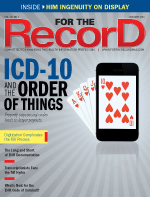January  2016
2016
Ask the Experts
For the Record
Vol. 28 No. 1 P. 29
Question:
I have been asked by several people recently what is required to become a Certified Coder. Are there any particular schools that are online that AHIMA recommends for training on ICD-10 coding? I know that all training programs are not equal and some are a waste of money. Who does AHIMA recommend? Does a good training program take a year to complete, or, if you attend full time, is a four-month program enough to pass the certification exams?
Patty Duke
Sentara Obici Hospital
Suffolk, Virginia
Response:
Certified Coders are in high demand, and the demands on them in the workforce are high as well. Coding accuracy is essential and ensuring high-quality training and education is critically important for supplying the workforce with qualified coders. There are many routes to become a credentialed coder and some are more rigorous than others.
Individuals who complete associate or baccalaureate degrees in HIM have a strong education-based foundation often accompanied by real-world professional practice experience in coding. These degree programs are generally two to four years in length.
The RHIT or RHIA credential that graduates of HIM programs accredited by the Commission on Accreditation for Health Informatics and Information Management Education, or CAHIIM, are eligible to test for recognizes that the programs include content allowing students to attain the necessary skills and competencies for a career in coding. Other individuals who may choose to go through a coding certificate program will find greater variation in the length of the program. AHIMA recommends that students select a coding program approved by the Professional Certificate Approval Program (PCAP) since these programs are evaluated for program content, delivery, faculty qualifications, and compliance with AHIMA curriculum standards for coding. Linking the certificate program education to credentials such as the CCA or CCS is the final step in demonstrating entry level coding skills attainment. PCAP-approved programs can be found by visiting www.ahima.org/careers/codingprograms.
— Desla Mancilla, DHA, RHIA, is the senior director of academic affairs for the AHIMA Foundation.
Question:
What is the ICD-10-CM correct code(s) for a periprosthetic fracture of the femur?
The patient recently had a total right knee replacement, and then suffered a fall resulting in a right periprosthetic supracondylar femur fracture. There is no evidence of fracture or loosening of the prosthesis. The fracture was comminuted with a fracture line extending down into the femoral component. An open reduction and internal fixation was performed using a locking plate and screws.
Pamela Grant, RHIT
Banner University Medicine
Tucson, Arizona
Response:
According to Coding Clinic 4th Quarter 2005, page 91, complications of prosthetic joint replacement can include infection, loosening of the prosthesis, dislocation of the prosthetic joint, periprosthetic fracture, articular surface wearing, and/or osteolysis. Fractures around the joint replacement prosthesis are called periprosthetic fractures. These fractures can occur with minimal trauma (especially with a previously loose prosthesis or osteoporotic bone).
A fracture of a prosthetic joint due to trauma should be coded to a traumatic fracture code with the appropriate code for the joint replacement to indicate the joint prosthesis status.
The ICD-10-CM correct code for a periprosthetic fracture of the femur is T84.042A, Periprosthetic fracture around internal prosthetic right knee joint, initial encounter.
If the documentation is not clear as to whether the fracture was actually a periprosthetic fracture or a fracture of the prosthetic joint, the physician should be queried.
— Kimberly Janet Carr, RHIT, CCS, CDIP, CCDS, is an AHIMA-approved ICD-10-CM/PCS trainer and director of clinical documentation for HRS.
Question:
Per the American Hospital Association's 2012 Coding Clinic regarding fetal nonstress tests, V72.85 and V22- were coded when there was no indication or reason for the test.
If we apply the same concept in ICD-10, it would mean Z01.89 and Z34- would be coded together. However, these codes are an Excludes1 and cannot be used together.
In these cases, what are your thoughts on proper code assignment?
Geneve Terry, RHIT
Community Healthcare System
Northwest Indiana
Response:
This is a very good question. We have found the best solution to report a fetal nonstress test for which the order does not communicate a specific diagnosis or a condition to rule out (Z03.7-) would be Z36 (encounter for antenatal screening of mother) and the appropriate Z3A- code to reflect the weeks of gestation if documented. Z36 would be more specific to the antenatal screening than Z01.89 other specified special examination. Won't it be nice when all of these unanswered ICD-10 questions are finally answered?
— Laurie Ercanbrack, CCS-P, CPC, is coding manager and Christina V., CCS, is a remote coding specialist at Coding Concepts LLC.
Have a coding or transcription question? Get an expert answer by sending an e-mail to edit@gvpub.com.



